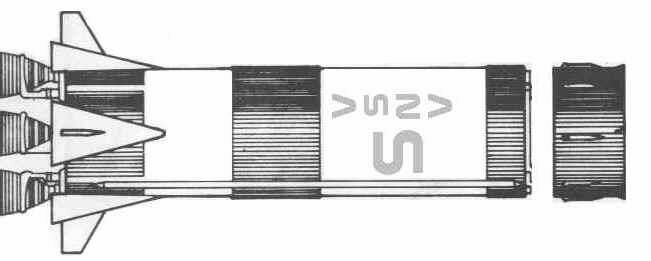
ANSA ARROW IV HEAVY LIFT
BOOSTER

STAGE 5 - PRIMARY HEAVY LIFTING BOOSTER
Stage 5-Primary Heavy Lifting Booster- Technical Specifications |
|
| Diameter of Stage 5 section: | 33 feet |
| Height of Stage 5 section: | 138 feet |
| Weight of Stage 5 section (fueled): | 5,100,000 lbs (fully fueled) |
| Weight of Stage 5 section (empty): | 300,000 lbs (empty) |
| Reaction Engines Installed in Stage 5: | 5 FJ1C-TS |
| Chemical Propellants Used For Fueling: | Liquid Hydrogen (350,000
gallons) Liquid Oxygen (100,000 gallons) RP-1 (Kerosene) (220,000 gallons) |
| Combined Thrust Output: | 10,000,000 lbs |
| Thrust Duration: | 128 seconds |
TECHNICAL DATA-The fifth stage is capable of burning over 20 tons of fuel per second during the two minutes of burn duration. This burn will take the vehicle to a height of about 36 nautical miles and accelerate the vehicle to a speed of over 6000 miles per hour. The FJ1C-TS engines work on a operation of modular pulse, with the individual venturi nozzles able to alter, on a micro-second by micro-second basis, the exact amount of thrust and fuel required to lift the payload into space.
COMBUSTION
PROCESS-FJ1C-TS MODEL ENGINE- Liquid hydrogen, refrigerated to a temperature
of 423 degrees F below zero, enters the fuel inlet valve, passes through the turbo fuel
pump, and moves through a cooling jacket that is integral to the exhaust nozzle of the
combustion chamber. This liquid hydrogen acts to cool the walls and protect them
from the destructive heat of the burning mixture of fuels taking place inside the
chamber. As the hydrogen passes through the cooling array, it is heated and turns
from a liquid to a gas which has a temperature of -100 degrees F. This rapidly
expanding gas passes through a turbine to furnish the mechanical power needed to pump more
hydrogen into the combustion chamber. The turbo pump sequence is controlled by
helium which actuates various mechanical switches in the system. The same turbine
also furnishes all the necessary power to keep liquid oxygen flowing through pumps and
into the main combustion chamber. |
|
